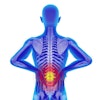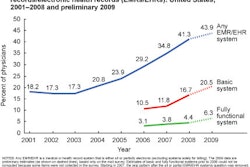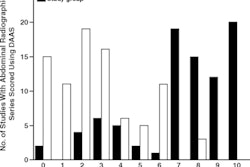How much structure is enough for structured radiology reports? That was the question asked at an RSNA meeting session, where a panel of technology evangelists and session attendees agreed that while more user-friendly structured reporting software would stimulate adoption, the technology behind it doesn't exist yet.
However, the question of whether structured reporting will be adopted by radiologists is a question of "when," not "if." Just as the use of speech recognition technology has been replacing medical transcriptionists over the past decade in many private practices and radiology departments, reports prepared in a consistent format amenable to data mining and using some form of standardized terminology will displace the preparation of entirely free-text reports.
The process has already begun.
Dr. Curtis Langlotz, chairman of the RSNA structured reporting subcommittee and professor and vice chair for informatics in the radiology department at the Hospital of the University of Pennsylvania in Philadelphia, chaired the session. A proponent and early pioneer of both speech recognition and structured reporting, Langlotz also has been a leading advocate of the need to standardize radiology terminology.
Other panel members included Dr. David Weiss, physician coordinator, imaging informatics, in the radiology department of Carilion Clinic in Roanoke, VA; Dr. Charles Kahn Jr., professor of radiology and chief of its division of informatics at the Medical College of Wisconsin in Milwaukee; and Dr. Elizabeth Burnside, a mammographer and associate professor of the University of Wisconsin School of Medicine and Public Health in Madison.
What's a structured report?
Langlotz defined the term "structured reports" at two levels. At its simplest, a structured report would utilize a format providing a consistent order of content, such as listing organs in a consistent order. It enters a higher level of complexity when it contains a standard lexicon of words, or macros, of standard terminology to describe exam techniques or common findings.
A structured report may also be a complete report with elements that can be modified as needed. During RSNA 2009, the RSNA launched a free downloadable library of radiology report templates representing the best-practice recommendations of more than 100 experts from 12 radiology specialties. These templates were prepared for use in whole or in part by practicing radiologists to promote excellence in radiology reporting.
Although structured reporting is often associated with speech recognition reporting, the panelists emphasized that while speech recognition software is an efficient tool, and may eventually be the best way of utilizing structured reporting, the two terms are not synonymous. Structured reporting may be used with traditional dictation as well, with references to macros to be added by traditional transcriptionists.
Adopting structured reporting
The RSNA template library is a good start to beginning to adopt standardized language, according to Langlotz. It's okay to use some but not all of the content and categories.
It's necessary to reach an agreement as to what is integral for a given template, Langlotz said. He suggested that radiologists discuss as a department or practice the elements of a radiology report that could use common language or terminology to begin the process of standardization.
Creating a macro for the technique used in each exam protocol is not only a great way to start, but it can save every radiologist dictation time. These are also easy to develop, because lists of protocols exist on the computer workstations of various modalities.
"It's best to start the adoption process with some easy wins and benefits that will help every radiologist," Langlotz said.
Kahn suggested that a good starting point would be to develop common language for the most frequently reported exams, a specific category of an exam, or all the exams of a specific modality. He noted that his department was creating templates for all ultrasound exams, that the radiologists at Johns Hopkins Hospital in Baltimore had created templates for all musculoskeletal exams, and that University of Michigan Health System's radiologists in Ann Arbor had developed reporting templates for both chest x-rays and thoracic CT exams.
"Look at the radiology report as the work product of radiologists, the vehicle by which we get paid," Kahn said. "The report is the transmission of my professional opinion of the images that I have seen conveying the relevant medical information into a context understandable to my referring physician colleagues."
"In most kinds of processes, we seek to drive out unnecessary variation because this can be a source of misunderstanding and error. This is also true of radiology reports. Both reimbursement and peer pressure can be a great motivation for collaboration," Kahn continued. "Our emergency physicians have given us a list of all the things they want to learn from specific CT exams performed on trauma patients. They say to us, 'If you don't mention each one of these items, we will assume that you didn't look. We'd also like to find your references to each in the same location of your report every time.' Now that is a great motivator for us to provide complete exams in a consistent format. These physicians are our customers, as well as the critically injured patients they treat."
Responding to a question about whether structured reporting should be used for complex as well as simple exams, Weiss pointed out that use with both types could be equally beneficial. "An angiography report is extremely long and complex. When I did consulting engagements, I found that people who embraced the use of some kind of template and structure for these exams were completing the reports faster because most of the elements in the content are going to be normal," he said.
"Technology is not yet optimizing what can be transferred directly from other parts of an electronic medical record, a radiology information system, or the scanner itself directly into a structured reporting template. I import as much RIS data as I can into my templates. But you are dependent upon the capabilities of the reporting system you are using to determine how easy it will be to set this up," Weiss explained.
Data transferring capability is not without caveats. Weiss explained that he used to import a patient's clinical history, but then realized that his reports included typographical errors and the linguistic style of the clerk who inputted the information. "Sometimes this would make me look stupid, so I don't do this anymore," he said. Currently he imports the date, time, study number, and name of ordering physician into his reports, which is faster and more efficient than entering this data himself.
Paying a premium
Efficiency, cost savings, and revenue generation are all motivators to get radiologists to adopt any technology, Kahn said. The U.S. Centers for Medicare and Medicaid Services (CMS) is paying a premium to have information reported with specific types of procedures. A structured reporting template can remind a radiologist to address this. He noted that anyone who flies in an airplane appreciates the fact that its pilot uses a checklist before takeoff, and that a structured reporting template can be viewed as a type of checklist. "We all get interrupted, and a list of items prevents us from forgetting where we left off," he said.
Burnside pointed out that structured formats and defined deliverables enable the performance of a radiologist to be measured. "Adopting the BI-RADS format for mammograms enables breast imagers to document what we are good at. We document our cancer detection rate and our recall rate. It is reassuring to know that you are practicing within the guidelines, and if you are not, you're aware that you need to improve."
"We do not have any turf battles with nonradiology specialties, because they know that their performance will be measured and that they will not be able to meet our performance levels. Structured reporting has made this happen," she said.
Burnside was asked if being judged against the performance of peers at a department and at a national level made her uncomfortable, and would this dissuade other templates that could measure standards from being developed. She replied that any radiologist should be accountable for his or her performance, and the ability to measure supports quality initiatives.
The Joint Commission is mandating that standards be set for critical results reporting. Adding standardized language for notification will enable a department to electronically validate that this is being done. Currently, efforts are under way to create assessment categories for liver masses (LI-RADS) and neck masses (NI-RADS).
Being forced to make a prediction and being held accountable for that prediction because it can be measured may be an uncomfortable concept to some radiologists, both panel members and attendees noted, but with the adoption of electronic medical records, this is an expectation. So, also, is the ability to data-mine the huge electronic repositories of clinical information with the potential to transform research opportunities, quality assurance analysis, and evidence-based medicine.
Attendees pointed out that a mammography report contains only four key elements and is simple to structure and quantify. The panel pointed out that cardiologists have adopted structured reporting and are ahead of radiologists, in great part for this reason. They have less than a dozen exams to deal with, whereas radiologists have hundreds. Cardiologists also have another motivation: The report is for their own use. If they dictate garbage, they deal with garbage, one attendee commented.
Another factor that has benefited the adoption of structured reporting by cardiologists is the fact that they are not looking at an exam when they are dictating it. They do the procedure, form their opinion, and then dictate. Navigation issues and the need to take eyes away from a diagnostic image are major hurdles to radiologists wanting to implement structured reporting software.
Technology isn't yet available to optimize this. There is no consensus with respect to how many selections and macro options for any given item in a structured report are appropriate and can be remembered. "The first commercial structured reporting software failed because it was dependent upon a pull-down menu, point-and-click architecture which hampered radiologist workflow," Langlotz said. Developing an intuitive voice- or microphone-button-driven workflow that does not decrease workflow efficiency and reporting productivity would be the key to success, he predicted, but the technology isn't available yet.
In addition to data mining, which cannot be done easily even with the use of natural language processing, new technology using digital structured reports will enable multiple reports to be automatically created. Data will be sliced and diced, one panelist predicted, with a single dictation assuming the form of a comprehensive report for a surgeon; a less complex report for the ordering physician with clearly defined recommendations, if needed, based on evidenced-based medicine; and a form written in layman's language for a patient.
However, free-text reporting will always be needed. To avoid commoditization, radiologists need to express their professionalism. One hundred percent utilization of canned terminology is neither realistic nor desired in terms of the complexity of the findings of diagnostic imaging.
What's next
So, what should radiologists do now?
Begin to discuss and adopt elements of structured reporting within a practice or department. Identify champions to make this happen. Start implementing. Hound vendors to make the process of integration with RIS and speech recognition systems easier.
"This is a chicken and egg scenario," Langlotz said. "Vendors need to understand what we need to make products that will surmount the workflow issues of today. We need to understand what exactly we need to achieve this. You can only do this by taking a test drive."
By Cynthia E. Keen
AuntMinnie.com staff writer
January 29, 2010
Related Reading
Free library of best practice report templates published by RSNA, December 2, 2009
ACR to create LI-RADS lexicon, September 4, 2009
Radiology reporting terms can confuse pediatricians, April 3, 2009
Speech recognition and structured reporting brings advantages, drawbacks, May 12, 2008
Meeting the challenge of structured reporting, June 23, 2006
Copyright © 2010 AuntMinnie.com



















